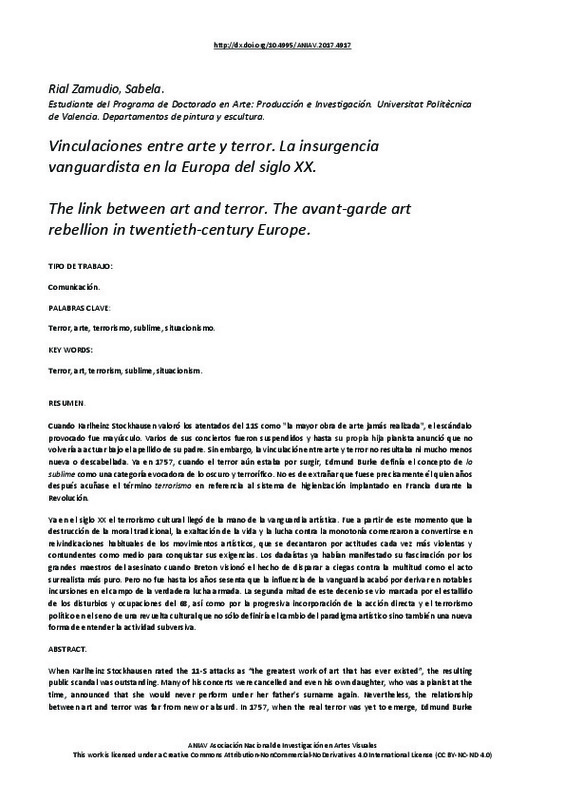JavaScript is disabled for your browser. Some features of this site may not work without it.
Buscar en RiuNet
Listar
Mi cuenta
Estadísticas
Ayuda RiuNet
Admin. UPV
Vinculaciones entre arte y terror. La insurgencia vanguardista en la Europa del siglo XX
Mostrar el registro sencillo del ítem
Ficheros en el ítem
| dc.contributor.author | Rial Zamudio, Sabela
|
es_ES |
| dc.date.accessioned | 2018-09-13T06:34:23Z | |
| dc.date.available | 2018-09-13T06:34:23Z | |
| dc.date.issued | 2017-10-23 | |
| dc.identifier.isbn | 9788490485736 | |
| dc.identifier.uri | http://hdl.handle.net/10251/107184 | |
| dc.description.abstract | [EN] When Karlheinz Stockhausen rated the 11HS attacks as “the greatest work of art that has ever existed”, the resulting public scandal was outstanding. Many of his concerts were cancelled and even his own daughter, who was a pianist at the time, announced that she would never perform under her father’s surname again. Nevertheless, the relationship between art and terror was far from new or absurd. In 1757, when the real terror was yet to emerge, Edmund Burke defined the concept of sublime as a category evoking darkness and terror. It is not surprising that the term terrorism was coined precisely by this same author years later to make reference to the hygenization systems implemented in France during the Revolution. Already in the twentieth century, cultural terrorism arrived from the hand of avant-garde art movements. It was from this moment that the destruction of traditional moral, the exaltation of life and the struggle against monotony started to become a usual topic addressed by artists, who chose more aggressive and forceful attitudes to meet their requirements. Dadaists had already expressed their fascination with the great masters of murder when Breton envisioned the act of blindly firing at a crowd as the purest surreal act. However, it was not until the sixties that the influence of avant-garde art led to significant incursions into the realm of true armed conflict. The second half of this decade was marked by the outbreak of riots and occupations in May ’6 , as well as by the gradual incorporation of direct action and political terrorism in the midst of a cultural revolution, that not only would define the change of the artistic paradigm, but also a new way of understanding subversive action. | es_ES |
| dc.description.abstract | [ES] Cuando Karlheinz Stockhausen valoró los atentados del 11S como "la mayor obra de arte jamás realizada", el escándalo provocado fue mayúsculo. Varios de sus conciertos fueron suspendidos y hasta su propia hija pianista anunció que no volvería a actuar bajo el apellido de su padre. Sin embargo, la vinculación entre arte y terror no resultaba ni mucho menos nueva o descabellada. Ya en 1757, cuando el terror aún estaba por surgir, Edmund Burke definía el concepto de lo sublime como una categoría evocadora de lo oscuro y terrorífico. No es de extrañar que fuese precisamente él quien años después acuñase el término terrorismo en referencia al sistema de higienización implantado en Francia durante la Revolución. Ya en el siglo XX el terrorismo cultural llegó de la mano de la vanguardia artística. Fue a partir de este momento que la destrucción de la moral tradicional, la exaltación de la vida y la lucha contra la monotonía comenzaron a convertirse en reivindicaciones habituales de los movimientos artísticos, que se decantaron por actitudes cada vez más violentas y contundentes como medio para conquistar sus exigencias. Los dadaístas ya habían manifestado su fascinación por los grandes maestros del asesinato cuando Breton visionó el hecho de disparar a ciegas contra la multitud como el acto surrealista más puro. Pero no fue hasta los años sesenta que la influencia de la vanguardia acabó por derivar en notables incursiones en el campo de la verdadera lucha armada. La segunda mitad de este decenio se vio marcada por el estallido de los disturbios y ocupaciones del 68, así como por la progresiva incorporación de la acción directa y el terrorismo político en el seno de una revuelta cultural que no sólo definiría el cambio del paradigma artístico sino también una nueva forma de entender la actividad subversiva. | es_ES |
| dc.format.extent | 8 | es_ES |
| dc.language | Español | es_ES |
| dc.publisher | Editorial Universitat Politècnica de València | es_ES |
| dc.relation.ispartof | Glocal [codificar, mediar, transformar, vivir] III Congreso Internacional de Investigación en Artes Visuales | es_ES |
| dc.rights | Reconocimiento - No comercial - Sin obra derivada (by-nc-nd) | es_ES |
| dc.subject | Terror | es_ES |
| dc.subject | Arte | es_ES |
| dc.subject | Terrorismo | es_ES |
| dc.subject | Sublime | es_ES |
| dc.subject | Situacionismo | es_ES |
| dc.subject | Art | es_ES |
| dc.subject | Terrorism | es_ES |
| dc.subject | Situacionism | es_ES |
| dc.title | Vinculaciones entre arte y terror. La insurgencia vanguardista en la Europa del siglo XX | es_ES |
| dc.title.alternative | The link between art and terror. The avant-garde art rebellion in twentieth-century Europe. | es_ES |
| dc.type | Capítulo de libro | es_ES |
| dc.type | Comunicación en congreso | es_ES |
| dc.identifier.doi | 10.4995/ANIAV.2017.4917 | |
| dc.rights.accessRights | Abierto | es_ES |
| dc.description.bibliographicCitation | Rial Zamudio, S. (2017). Vinculaciones entre arte y terror. La insurgencia vanguardista en la Europa del siglo XX. En Glocal [codificar, mediar, transformar, vivir] III Congreso Internacional de Investigación en Artes Visuales. Editorial Universitat Politècnica de València. 592-599. https://doi.org/10.4995/ANIAV.2017.4917 | es_ES |
| dc.description.accrualMethod | OCS | es_ES |
| dc.relation.conferencename | III Congreso Internacional de Investigación en Artes Visuales :: ANIAV 2017 :: GLOCAL | es_ES |
| dc.relation.conferencedate | Julio 06-07,2017 | es_ES |
| dc.relation.conferenceplace | Valencia, Spain | es_ES |
| dc.relation.publisherversion | http://ocs.editorial.upv.es/index.php/ANIAV/ANIAV2017/paper/view/4917 | es_ES |
| dc.description.upvformatpinicio | 592 | es_ES |
| dc.description.upvformatpfin | 599 | es_ES |
| dc.type.version | info:eu-repo/semantics/publishedVersion | es_ES |
| dc.relation.pasarela | OCS\4917 | es_ES |








